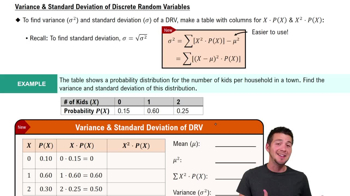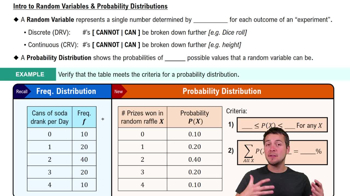A student is analyzing different types of variables in a statistics class. Which of the following below is a discrete random variable?
Table of contents
- 1. Intro to Stats and Collecting Data1h 14m
- 2. Describing Data with Tables and Graphs1h 55m
- 3. Describing Data Numerically2h 5m
- 4. Probability2h 16m
- 5. Binomial Distribution & Discrete Random Variables3h 6m
- 6. Normal Distribution and Continuous Random Variables2h 11m
- 7. Sampling Distributions & Confidence Intervals: Mean3h 23m
- Sampling Distribution of the Sample Mean and Central Limit Theorem19m
- Distribution of Sample Mean - Excel23m
- Introduction to Confidence Intervals15m
- Confidence Intervals for Population Mean1h 18m
- Determining the Minimum Sample Size Required12m
- Finding Probabilities and T Critical Values - Excel28m
- Confidence Intervals for Population Means - Excel25m
- 8. Sampling Distributions & Confidence Intervals: Proportion1h 12m
- 9. Hypothesis Testing for One Sample3h 29m
- 10. Hypothesis Testing for Two Samples4h 50m
- Two Proportions1h 13m
- Two Proportions Hypothesis Test - Excel28m
- Two Means - Unknown, Unequal Variance1h 3m
- Two Means - Unknown Variances Hypothesis Test - Excel12m
- Two Means - Unknown, Equal Variance15m
- Two Means - Unknown, Equal Variances Hypothesis Test - Excel9m
- Two Means - Known Variance12m
- Two Means - Sigma Known Hypothesis Test - Excel21m
- Two Means - Matched Pairs (Dependent Samples)42m
- Matched Pairs Hypothesis Test - Excel12m
- 11. Correlation1h 6m
- 12. Regression1h 50m
- 13. Chi-Square Tests & Goodness of Fit1h 57m
- 14. ANOVA1h 57m
5. Binomial Distribution & Discrete Random Variables
Discrete Random Variables
Problem 5.1.2
Textbook Question
Discrete or Continuous? Is the random variable given in the table from Exercise 1 discrete or continuous? Explain.
 Verified step by step guidance
Verified step by step guidance1
Understand the definitions: A discrete random variable takes on a countable number of distinct values (e.g., integers, finite or countably infinite), while a continuous random variable can take on any value within a given range or interval (e.g., real numbers).
Examine the random variable provided in Exercise 1. Determine whether the values it can take are countable (e.g., 0, 1, 2, ...) or if they can take on any value within a range (e.g., 1.5, 2.3, etc.).
If the random variable represents something like the number of occurrences of an event (e.g., number of cars, number of students), it is likely discrete. If it represents measurements (e.g., height, weight, time), it is likely continuous.
Check whether the random variable is described in terms of intervals or specific points. Discrete variables are often associated with specific points, while continuous variables are associated with ranges or intervals.
Based on the analysis, classify the random variable as either discrete or continuous and provide a brief explanation of why it fits that classification.
 Verified video answer for a similar problem:
Verified video answer for a similar problem:This video solution was recommended by our tutors as helpful for the problem above
Video duration:
2mPlay a video:
Was this helpful?
Key Concepts
Here are the essential concepts you must grasp in order to answer the question correctly.
Discrete Random Variables
Discrete random variables are those that can take on a countable number of distinct values. Examples include the number of students in a classroom or the outcome of rolling a die. These variables often arise in situations where the data can be enumerated, and they typically involve whole numbers.
Recommended video:
Guided course

Variance & Standard Deviation of Discrete Random Variables
Continuous Random Variables
Continuous random variables, in contrast, can take on an infinite number of values within a given range. They are often associated with measurements, such as height, weight, or temperature. These variables can be represented on a number line and can include fractions and decimals, making them uncountable.
Recommended video:
Guided course

Intro to Random Variables & Probability Distributions
Identifying Random Variables
To determine whether a random variable is discrete or continuous, one must analyze the nature of the data it represents. If the values can be listed or counted, it is discrete; if the values can vary continuously and include fractions, it is continuous. This distinction is crucial for selecting appropriate statistical methods for analysis.
Recommended video:
Guided course

Intro to Random Variables & Probability Distributions

 7:09m
7:09mWatch next
Master Intro to Random Variables & Probability Distributions with a bite sized video explanation from Patrick
Start learningRelated Videos
Related Practice
Multiple Choice
